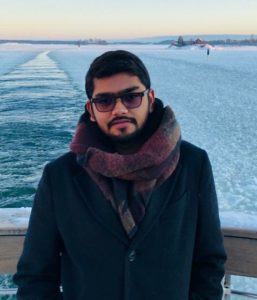ESR 3 – Anirudh Puligandla
3D technology has been a key aspect in storytelling and robotic exploration over the past decade. With ever increasing computing power, 3D technology is becoming an integral part with vision in any field. 3D content, now, has the potential to provide much needed assistance in the fields of medicine, education, navigation, exploration, surveillance and story-telling among many other fields.
The primary goal of the project is to devel op multi-camera systems to visualize the surroundings of heavy work machines. The project can be split into interrelated sub-topics. Firstly, algorithms need to be developed to automatically place cameras on the vehicle/machine so as to visualize the surroundings at minimal cost. The challenges involved under this topic will be to accurately calibrate and stitch content from various cameras taking into considereation the variable brigthness, view-points and other camera parameters. The second objective is to integrate non-visual sensors (e.g, lidars) to obtain accurate 3D reconstructions of the surrounding area.
op multi-camera systems to visualize the surroundings of heavy work machines. The project can be split into interrelated sub-topics. Firstly, algorithms need to be developed to automatically place cameras on the vehicle/machine so as to visualize the surroundings at minimal cost. The challenges involved under this topic will be to accurately calibrate and stitch content from various cameras taking into considereation the variable brigthness, view-points and other camera parameters. The second objective is to integrate non-visual sensors (e.g, lidars) to obtain accurate 3D reconstructions of the surrounding area.
The above mentioned work will be done in the context of emergency response as that is one the key aspects of the ImmerSafe project. The final outcome after accomplishing the technical tasks is to assist emergency response teams to be able to better deliver rescue or search services in dire situations.
Progress and Research Outcomes
The project focussed primarily on camera placement optimization problems as there was a dearth of research on this problem for the specific use case of vehicle surround view. The primary challenge in modelling a camera placement optimization problem was the use discrete space models. Discrete space models tend to be time and resource intensive but provides a sufficient approximation for the complex geometry involved in these problems. In the context of vehicle surround view, the problem was explored in both discrete space and continuous space settings. The research resulted in a discrete optimization model for our use case with an improved optimization strategy to overcome resource limitations and to reduce computational time by large factor. The continuous space model allowed the use of high quality 3D models of vehicles with a high degree of accuracy in the placement of cameras on the vehicle’s 3D model. This method also achieves further reduction in computational complexity allowing its use for real world scenarios. This project resulted in the following contributions:
Puligandla VA, Lončarić S. A Multiresolution Approach for Large Real-World Camera Placement Optimization Problems. IEEE Access. 2022 May 23; 10:61601-16.
Puligandla VA, Lončarić S. A Supervoxel Segmentation Method With Adaptive Centroid Initialization for Point Clouds. IEEE Access. 2022 Sep 12;10:98525-34.
Puligandla VA, Lončarić S. Optimal Camera Placement to Visualize Surrounding View From Heavy Machinery. In Proceedings of the 2020 2nd Asia Pacific Information Technology Conference 2020 Jan 17 (pp. 52-59).
Puligandla VA, Lončarić S. 3D optimal placement of cameras. 4th International Workshop on Data Science 2019 Oct 15. (Poster)
Puligandla VA, Lončarić S. Optimal Camera Placement for Heavy Vehicle Surround View. 9th Croatian Computer Vision Workshop. 2021 (Poster)
Puligandla VA, Lončarić S., Optimal Camera Placement to Visualize Surrounding View From Heavy Machinery, ImmerSAFE special session at the 11th International Symposium on Image and Signal Processing and Analysis (ISPA 2019) (Presentation)
Anirudh received a Joint Master degree (Erasmus Mundus) in computer vision and robotics from University of burgundy (France), University of Girona (Spain) and Heriot Watt university (Edinburgh) in 2018. He has a BSc in Computer Vision and Robotics (2015-16) from university of Burgundy. He completed a Bachelor of Technology (B.tech) in electronics and communication engineering from Amity University, Rajasthan, India in 2014.

 This project has received funding from the European Union’s Horizon 2020 research and innovation programme under the Marie Sklodowska-Curie grant agreement No 764951.
This project has received funding from the European Union’s Horizon 2020 research and innovation programme under the Marie Sklodowska-Curie grant agreement No 764951.